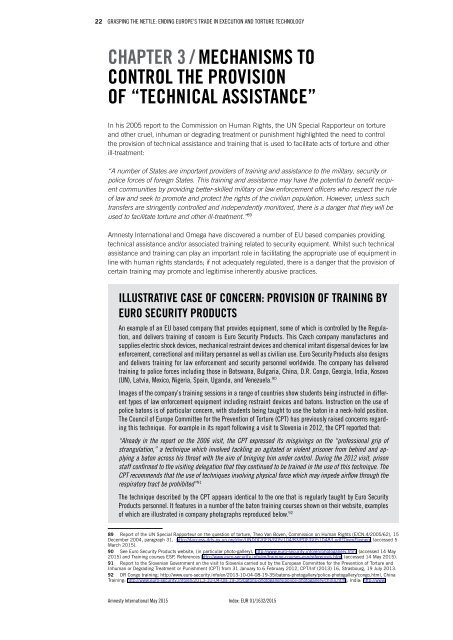Grasping the nettle
1Gsbbd6
1Gsbbd6
Create successful ePaper yourself
Turn your PDF publications into a flip-book with our unique Google optimized e-Paper software.
22 <strong>Grasping</strong> <strong>the</strong> <strong>nettle</strong>: Ending Europe’s Trade in Execution and Torture Technology<br />
Chapter 3 / Mechanisms to<br />
control <strong>the</strong> provision<br />
of “technical assistance”<br />
In his 2005 report to <strong>the</strong> Commission on Human Rights, <strong>the</strong> UN Special Rapporteur on torture<br />
and o<strong>the</strong>r cruel, inhuman or degrading treatment or punishment highlighted <strong>the</strong> need to control<br />
<strong>the</strong> provision of technical assistance and training that is used to facilitate acts of torture and o<strong>the</strong>r<br />
ill-treatment:<br />
“A number of States are important providers of training and assistance to <strong>the</strong> military, security or<br />
police forces of foreign States. This training and assistance may have <strong>the</strong> potential to benefit recipient<br />
communities by providing better-skilled military or law enforcement officers who respect <strong>the</strong> rule<br />
of law and seek to promote and protect <strong>the</strong> rights of <strong>the</strong> civilian population. However, unless such<br />
transfers are stringently controlled and independently monitored, <strong>the</strong>re is a danger that <strong>the</strong>y will be<br />
used to facilitate torture and o<strong>the</strong>r ill-treatment.” 89<br />
Amnesty International and Omega have discovered a number of EU based companies providing<br />
technical assistance and/or associated training related to security equipment. Whilst such technical<br />
assistance and training can play an important role in facilitating <strong>the</strong> appropriate use of equipment in<br />
line with human rights standards; if not adequately regulated, <strong>the</strong>re is a danger that <strong>the</strong> provision of<br />
certain training may promote and legitimise inherently abusive practices.<br />
Illustrative case of concern: provision of training by<br />
Euro Security Products<br />
An example of an EU based company that provides equipment, some of which is controlled by <strong>the</strong> Regulation,<br />
and delivers training of concern is Euro Security Products. This Czech company manufactures and<br />
supplies electric shock devices, mechanical restraint devices and chemical irritant dispersal devices for law<br />
enforcement, correctional and military personnel as well as civilian use. Euro Security Products also designs<br />
and delivers training for law enforcement and security personnel worldwide. The company has delivered<br />
training to police forces including those in Botswana, Bulgaria, China, D.R. Congo, Georgia, India, Kosovo<br />
(UN), Latvia, Mexico, Nigeria, Spain, Uganda, and Venezuela. 90<br />
Images of <strong>the</strong> company’s training sessions in a range of countries show students being instructed in different<br />
types of law enforcement equipment including restraint devices and batons. Instruction on <strong>the</strong> use of<br />
police batons is of particular concern, with students being taught to use <strong>the</strong> baton in a neck-hold position.<br />
The Council of Europe Committee for <strong>the</strong> Prevention of Torture (CPT) has previously raised concerns regarding<br />
this technique. For example in its report following a visit to Slovenia in 2012, <strong>the</strong> CPT reported that:<br />
“Already in <strong>the</strong> report on <strong>the</strong> 2006 visit, <strong>the</strong> CPT expressed its misgivings on <strong>the</strong> “professional grip of<br />
strangulation,” a technique which involved tackling an agitated or violent prisoner from behind and applying<br />
a baton across his throat with <strong>the</strong> aim of bringing him under control. During <strong>the</strong> 2012 visit, prison<br />
staff confirmed to <strong>the</strong> visiting delegation that <strong>the</strong>y continued to be trained in <strong>the</strong> use of this technique. The<br />
CPT recommends that <strong>the</strong> use of techniques involving physical force which may impede airflow through <strong>the</strong><br />
respiratory tract be prohibited” 91<br />
The technique described by <strong>the</strong> CPT appears identical to <strong>the</strong> one that is regularly taught by Euro Security<br />
Products personnel. It features in a number of <strong>the</strong> baton training courses shown on <strong>the</strong>ir website, examples<br />
of which are illustrated in company photographs reproduced below. 92<br />
89 Report of <strong>the</strong> UN Special Rapporteur on <strong>the</strong> question of torture, Theo Van Boven, Commission on Human Rights (E/CN.4/2005/62), 15<br />
December 2004, paragraph 31, http://daccess-dds-ny.un.org/doc/UNDOC/GEN/G05/104/83/PDF/G0510483.pdf?OpenElement (accessed 5<br />
March 2015).<br />
90 See Euro Security Products website, (in particular photo-gallery), http://www.euro-security.info/en/photogallery.html (accessed 14 May<br />
2015) and Training courses ESP, References http://www.euro-security.info/en/training-courses-esp/references.html (accessed 14 May 2015).<br />
91 Report to <strong>the</strong> Slovenian Government on <strong>the</strong> visit to Slovenia carried out by <strong>the</strong> European Committee for <strong>the</strong> Prevention of Torture and<br />
Inhuman or Degrading Treatment or Punishment (CPT) from 31 January to 6 February 2012, CPT/Inf (2013) 16, Strasbourg, 19 July 2013.<br />
92 DR Congo training: http://www.euro-security.info/en/2013-10-04-08-19-35/batons-photogallery/police-photogallery/congo.html, China<br />
Training: http://www.euro-security.info/en/2013-10-04-08-19-35/batons-photogallery/police-photogallery/china.html, India: http://www.<br />
Amnesty International May 2015 Index: EUR 01/1632/2015


